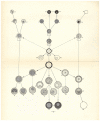Ambiguous cells: the emergence of the stem cell concept in the nineteenth and twentieth centuries
- PMID: 22332468
- PMCID: PMC3793240
- DOI: 10.1098/rsnr.2011.0023
Ambiguous cells: the emergence of the stem cell concept in the nineteenth and twentieth centuries
Abstract
This paper elucidates the origins of scientific work on stem cells. From the late nineteenth century onwards, the notion of stem cells became customary in scientific communities of Imperial Germany. Adopting the term Stammzelle from Ernst Haeckel, Theodor Boveri was influential in introducing the concept in embryological studies and early genetics around 1900, describing a capacity of stem cells for self-renewal as well as differentiation. At the same time, blood stem cells were conceptualized by histologists such as Ernst Neumann and Artur Pappenheim in studies of physiological haematopoiesis and various forms of leukaemia. Furthermore, building on Julius Cohnheim's theory that tumours arise from 'embryonic remnants' in the adult body, pathologists aimed at identifying the cells of origin, particularly in the embryo-like teratomas. Embryonic stem cells thus assumed an ambiguous status, partly representing common heritage and normal development, and partly being seen as potential causes of cancer if they had been left behind or displaced during ontogeny. In the 1950s and 1960s experimental research on teratocarcinomas by Leroy Stevens and Barry Pierce in the USA brought together the strands of embryological and pathological work. Alongside the work of Ernest McCulloch and James Till at the Ontario Cancer Institute from the early 1960s on stem cells in haematopoiesis, this led into the beginnings of modern stem cell research.
Figures


References
-
- Burns L. You are our only hope”: Trading metaphorical “magic bullets” for stem cell “superheroes. Theoretical Medicine and Bioethics. 2009;30:427–42. - PubMed
-
- Musolff A. Progressive” evolution and “totipotent” stem cells: metaphors in British and German debates about the “life sciences. IBÉRICA. 2009;17:45–59.
-
- Fagan MB. The search for the hematopoietic stem cell: social interaction and epistemic success in immunology. Studies in History and Philosophy of Biological and Biomedical Sciences. 2007;38:217–37. - PubMed
- eadem Stems and standards: social interaction in the search for blood stem cells. Journal of the History of Biology. 2010;43:67–109. - PubMed
- Kraft A. Manhattan transfer: lethal radiation, bone marrow transplantation, and the birth of stem cell biology, ca. 1942-1961. Historical Studies in the Natural Sciences. 2009;39:171–218. - PubMed
- eadem Converging histories, reconsidered potentialities: The stem cell and cancer. BioSocieties. advance online publ. 9 May 2011, 1-22. For historical accounts of embryonic stem cell research see note 91, below.
-
- Ramalho-Santos M, Willenbring H. On the origin of the term “stem cell”. Cell Stem Cell. 2007;1:35–8. - PubMed
-
- Richards RJ. The tragic sense of life: Ernst Haeckel and the struggle over evolutionary thought. University of Chicago Press; Chicago: 2008.
Publication types
MeSH terms
Grants and funding
LinkOut - more resources
Full Text Sources
Other Literature Sources
Medical
